This step by step diy woodworking project is about a 16×18 outdoor lean to pavilion plans. I have designed this large rectangular pavilion made from 6×6 lumber, so it can be sturdy and simple to build as a DIY project. The roof has a 4:12 pitch and it is sheeted with plywood then asphalt shingled are installed. Take a look over the rest of our woodworking plans, if you want to get more building inspiration.
When buying the lumber, you should select the planks with great care, making sure they are straight and without any visible flaws (cracks, knots, twists, decay). Investing in cedar or other weather resistant lumber is a good idea, as it will pay off on the long run. Use a spirit level to plumb and align the components, before inserting the galvanized screws, otherwise the project won’t have a symmetrical look. If you have all the materials and tools required for the project, you could get the job done in about a day. See all my Premium Plans HERE.
Projects made from these plans
16×18 Lean to Pavilion – Free DIY Plans
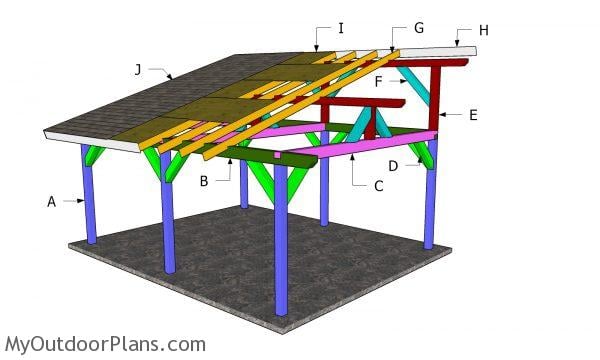
Building a 16×20 lean to pavilion
Cut & Shopping Lists
- A – 6 pieces of 6×6 lumber – 8 ft long POSTS
- B – 2 pieces of 6×8 lumber – 11 ft long, 2 pieces – 9 ft long TOP PLATES
- C – 3 pieces of 6×8 lumber – 16 ft long CROSSBEAMS
- D – 12 pieces of 6×6 lumber – 36″ long BRACES
- 6 pieces of 6×6 lumber – 8 ft
- 3 pieces of 6×6 lumber – 12 ft
- 2 pieces of 6×8 lumber – 12 ft
- 3 pieces of 6×8 lumber – 16 ft
- 2 pieces of 6×8 lumber – 10 ft
- 16 pieces of 8″ screws, 16 pieces of 10″ screws
- post hole digger
- 6 6×6 post anchors
- 48 pieces of 5 1/2″ screws
- wood glue, stain/paint
Tools
![]() Hammer, Tape measure, Framing square, Level
Hammer, Tape measure, Framing square, Level
![]() Miter saw, Drill machinery, Screwdriver, Sander
Miter saw, Drill machinery, Screwdriver, Sander
Time
Related
- PART 1: 16×18 Pavilion Plans
- PART 2: 16x18 Pavilion Roof Plans
How to build a 16×18 pavilion

Laying-out-the-posts
The first step of the project is to layout the posts for the 16×18 pavilion. Use batter boards and string to determine the location of the posts. Apply the 3-4-5 rule to every corner of the pavilion, so you make sure they are right angled.
Moreover measure the diagonals and make sure they are equal. Determining the location for the pavilion is essential, as you have to comply with the local building codes. Make sure the surface is level and remove the vegetation layer.
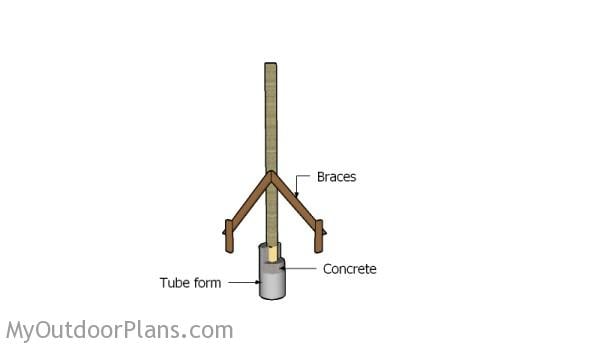
Setting the posts in concrete
Dig 3′ deep holes into the ground with a post hole digger. Align the holes with attention and then fit form tubes. Fill the holes with concrete and install the post anchors. Let the concrete to dry out.
Use a spirit level to plumb the posts and then lock them into place with temporarily braces. Secure the posts to the anchors.
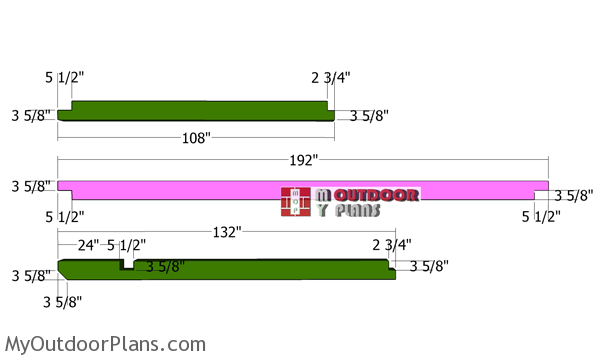
Top-plate-beams
Use 6×8 lumber for the top plates of the pavilion. Use a circular saw to make the notches to beams, as shown in the diagram. Make parallel cuts inside the marked areas and then remove the excess with a chisel. Smooth the surface with sandpaper.

Fitting-the-side-top-plates
Fit the top plates to the sides of the pavilion. Notice the overhangs to the beams on the front of the pavilion. Make sure the corners are square and check if the beams are horizontal. Drill pilot holes through the top of the beams and insert 8″ screws into the posts.
If the top of the posts are not at the same level, use a laser level and a circular saw to adjust them.
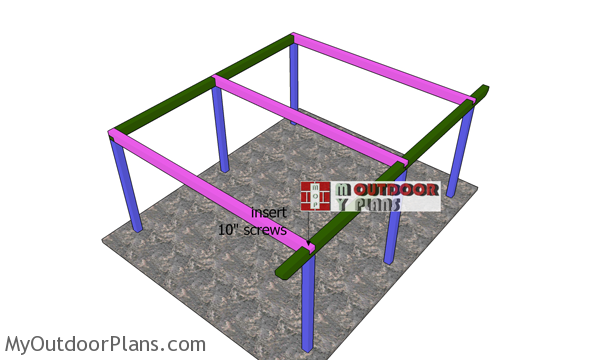
Fitting-the-cross-beams
Fit the cross-beams to the top of the posts. Plumb the posts with a spirit level and make sure the plates are horizontal. Check if the corners are square and align the edges with attention. Drill pilot holes through the plates and insert 10″ screws into the top of the posts.

Braces
Use 6×6 lumber for the braces. Double check if the posts are plumb and if the corners are square. Cut both ends of the braces at 45 degrees and then secure them into place with 5 1/2″ screws, after drilling pilot holes. These braces will really enhance the rigidity of the pavilion, so make sure you don’t take shortcuts and install them properly.
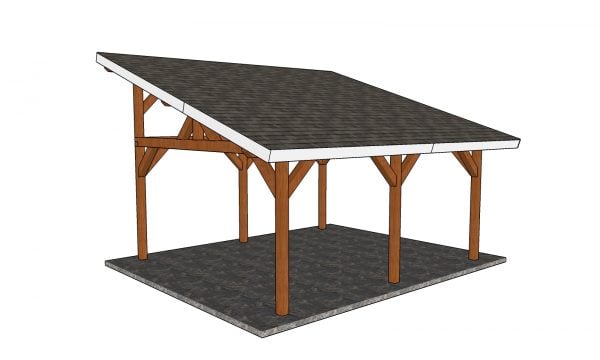
16×18 Lean to Pavilion Plans Free
This rectangular pavilion with a lean to roof makes for a perfect retreat area in your garden. You will have a shaded area that is ideal for hang outs with family and friends.

How-to-build-a-16×18-pavilion—lean-to-roof
Fill the holes with wood putty and let them dry out for a few hours. Smooth the surface with 100-220 grit sandpaper and remove the residues with a damp cloth. Check out PART 2 of the project, to learn how to make the lean to roof of the pavilion.
Top Tip: Apply a few coats of paint or stain to the components, to enhance the look of the project. Make sure you take a look over the rest of my pergola/gazebo/pavilion plans HERE. See all my free woodworking plans (over 1000) HERE. This 16×18 lean to pavilion is also available as a Premium Plan (1 PDF file with full Cut & Shopping lists, Cut diagram Layout), by clicking the Get PDF Plans button bellow.
This woodworking project was about 16×18 lean to pavilion plans free. If you want to see more outdoor plans, check out the rest of our step by step projects and follow the instructions to obtain a professional result. Feel free to SHARE my plans with your friends.


